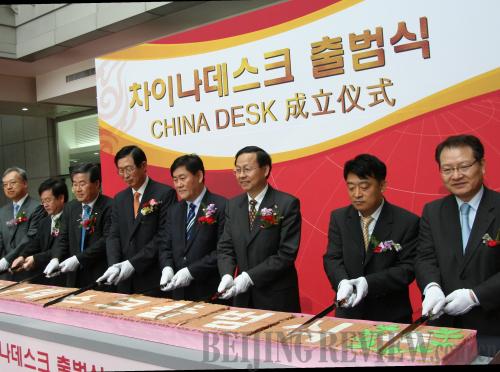| 
Should East Asia pursue economic integration through the East Asia Free Trade Area (EAFTA) or the Comprehensive Economic Partnership in East Asia (CEPEA)? This topic has long been debated, with no clear decision being made.
Both the EAFTA and the CEPEA are free trade arrangements. The EAFTA, made up of the 10 ASEAN nations plus China, Japan and South Korea, was proposed by the East Asia Vision Group in 2001. China and the ASEAN nations responded positively.
The CEPEA, made up of the 10 ASEAN nations plus China, Japan, South Korea, Australia, New Zealand and India, was proposed by Japan in 2006. It was said the CEPEA was intended to prevent China from obtaining a dominant status in the EAFTA. Thus, responses were varied. The ongoing debate comes down to a choice between the EAFTA's 10+3 structure and the CEPEA's 10+6.
 |
|
INVEST MORE: Chinese Ambassador to South Korea Zhang Xinsen (third right), South Korean Minister of Knowledge Economy Choi Kyung Hwan (fourth right) and CEO of the Korea Trade-Investment Promotion Agency (KOTRA) Cho Hwan Eik (fourth left) attend the opening ceremony of the KOTRA's new China Desk, designed to help promote Chinese investment in South Korea, in Seoul on May 6 (XINHUA) |
At the Second East Asia Summit in 2007, a study by scholars and academics on the feasibility of the CEPEA was requested. But the summit did not give a clear response to their annual reports in the next two years. At the 2009 ASEAN Summit, high-level economic officials were asked to prepare suggestions on the EAFTA and the CEPEA for the next ASEAN Summit, scheduled for October 2010.
Pragmatically, East Asia should first be committed to the EAFTA and then pursue the CEPEA.
First of all, the EAFTA has made initial progress in economic cooperation and institutional development. Its economic integration is well ahead of the CEPEA's, and it has achieved a good deal, including the creation of a regional currency swap mechanism based on the Chiang Mai Initiative. In addition, it has established a regional foreign exchange reserve pool, developed Asian bond markets, promoted cooperation in the Greater Mekong Sub-region, and stepped up infrastructure construction to enhance regional interconnectivity.
Strong cooperation has been exercised between ASEAN nations and the three countries of China, Japan and South Korea. This should facilitate the continuous development of regional economic integration.
The CEPEA, by contrast, is currently just a concept and a vision. There is a lack of concrete cooperation within this framework, and there has been very little development of institutions and mechanisms for cooperation.
Second, the establishment of a free trade area should be carried out methodically and pragmatically. Within the 10+3 framework, ASEAN has initiated free trade agreements with China, Japan and South Korea.
Within the 10+6 framework, ASEAN has signed free trade agreements with India, Australia and New Zealand. India has a free trade agreement with South Korea, and New Zealand has free trade agreements with China and Australia. Similar agreements, however, have yet to be reached among other countries in the region.
Regardless of whether the chosen route goes through the EAFTA or the CEPEA, the signing of a China-Japan-South Korea free trade agreement, or bilateral free trade agreements between them, is a major challenge. If this challenge is not addressed, it would be meaningless to carry out further steps. Therefore, it would be practical to pursue the EAFTA before going on to explore the CEPEA.
Finally, the more parties a free trade agreement involves, the more complicated negotiations become. The challenges in the Doha Round WTO negotiations are a telling example. With this in mind, EAFTA negotiations may be easier than CEPEA negotiations.
It is both practical and feasible to start with the EAFTA and then expand to the CEPEA. This follows the line of reasoning that simple matters should be taken care of before more complicated ones and that a tough task should be dealt with one step at a time. Such an approach may finally help achieve economic integration in East Asia.
The author is the Secretary General of the China National Committee for Pacific Economic Cooperation | 